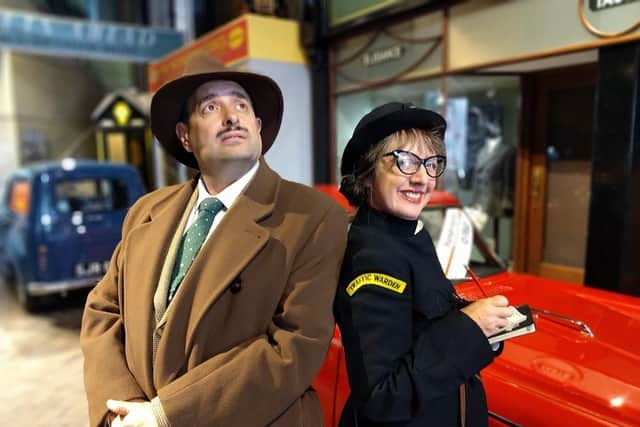Nostalgic Streets Ahead opened at the National Motor Museum
and live on Freeview channel 276
As part of the opening weekend celebration, visitors enjoyed meeting a traffic warden, milkman, a bus conductor, and a motor salesman spiv. Younger visitors were intrigued to hear stories from the era – including wider opportunities for travel, changing tastes of fashion, the fight for equal pay, whilst those old enough to remember reminisced about the car and motorcycles on the street.
The new gallery Streets Ahead: Motoring in Mid-Century Britain displays artefacts from the Museum’s extensive motoring collections in shop fronts on the street; a toy shop with treasured playthings such as Corgi toys and Scalextric, a motoring clothing shop boasting sensible or fashionable outerwear and accessories, a travel agent that brought holidays abroad as well as UK trips and excursions to the masses for the first time. A mobile hardware store is also parked up showing a form of shopping when roads and perhaps lives were less busy.
Advertisement
Hide AdAdvertisement
Hide AdMuseum Chief Executive, Jon Murden says, “The re-development of this section of the Museum into Streets Ahead is a wonderful addition to our displays. It is an opportune moment to look back, at a time when the high-street is experiencing yet another revolution in shopping habits.”


National Motor Museum Senior Curator, Gail Stewart-Bye says, “The decades following the Second World War saw full employment, a growing population, greater affluence, the emergence of the ‘teenager’ as a distinct sector of society, and an explosion in the affordability and availability of consumer goods, all of which fuelled a booming economy.
Gail says that motoring was central to this transformation, “Cars and motorcycles became accessible to more people than ever before. Mass motor vehicle ownership, and the freedom for everyone to travel was part of the shared experience of post-war life. Through travel, fashion, in entertainment, and whilst growing up, motoring became a significant part of popular culture.”
The exhibition is included in the admission ticket for the Beaulieu attraction, and further details are available from www.nationalmotormuseum.org.uk